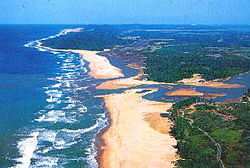| Marine habitats |
|---|
 |
| Coastal habitats |
| Ocean surface |
| Open ocean |
| Sea floor |
A marine coastal ecosystem is a marine ecosystem which occurs where the land meets the ocean. Marine coastal ecosystems include many very different types of marine habitats, each with their own characteristics and species composition. They are characterized by high levels of biodiversity and productivity.
For example, estuaries are areas where freshwater rivers meet the saltwater of the ocean, creating an environment that is home to a wide variety of species, including fish, shellfish, and birds. Salt marshes are coastal wetlands which thrive on low-energy shorelines in temperate and high-latitude areas, populated with salt-tolerant plants such as cordgrass and marsh elder that provide important nursery areas for many species of fish and shellfish. Mangrove forests survive in the intertidal zones of tropical or subtropical coasts, populated by salt-tolerant trees that protect habitat for many marine species, including crabs, shrimp, and fish.
Further examples are coral reefs and seagrass meadows, which are both found in warm, shallow coastal waters. Coral reefs thrive in nutrient-poor waters on high-energy shorelines that are agitated by waves. They are underwater ecosystem made up of colonies of tiny animals called coral polyps. These polyps secrete hard calcium carbonate skeletons that builds up over time, creating complex and diverse underwater structures. These structures function as some of the most biodiverse ecosystems on the planet, providing habitat and food for a huge range of marine organisms. Seagrass meadows can be adjacent to coral reefs. These meadows are underwater grasslands populated by marine flowering plants that provide nursery habitats and food sources for many fish species, crabs and sea turtles, as well as dugongs. In slightly deeper waters are kelp forests, underwater ecosystems found in cold, nutrient-rich waters, primarily in temperate regions. These are dominated by a large brown algae called kelp, a type of seaweed that grows several meters tall, creating dense and complex underwater forests. Kelp forests provide important habitats for many fish species, sea otters and sea urchins.
Directly and indirectly, marine coastal ecosystems provide vast arrays of ecosystem services for humans, such as cycling nutrients and elements, and purifying water by filtering pollutants. They sequester carbon as a cushion against climate change. They protect coasts by reducing the impacts of storms, reducing coastal erosion and moderating extreme events. They provide essential nurseries and fishing grounds for commercial fisheries. They provide recreational services and support tourism.
These ecosystems are vulnerable to various anthropogenic and natural disturbances, such as pollution, overfishing, and coastal development, which have significant impacts on their ecological functioning and the services they provide. Climate change is impacting coastal ecosystems with sea level rises, ocean acidification, and increased storm frequency and intensity. When marine coastal ecosystems are damaged or destroyed, there can be serious consequences for the marine species that depend on them, as well as for the overall health of the ocean ecosystem. Some conservation efforts are underway to protect and restore marine coastal ecosystems, such as establishing marine protected areas and developing sustainable fishing practices.
© MMXXIII Rich X Search. We shall prevail. All rights reserved. Rich X Search
